LG G2 and MSM8974 Snapdragon 800 - Mini Review
by Brian Klug on September 7, 2013 1:11 AM EST- Posted in
- Smartphones
- LG
- Mobile
- LG G2
- Android 4.2
- MSM8974
- Snapdragon 800
Display
We've been very pleased with what comes out of LG Display as of late, and the G2 doesn't disappoint. It's a 5.2-inch diagonal LCD with 1920x1080 resolution for 423 PPI density. Of course, it isn't just resolution that matters, but of course calibration, viewing angles, and other quality measures. What's interesting about the G2 is that it has two discrete touchscreen matrices which get routed to the top and bottom and out two different connectors. LG says this allows it to get the bezels on the G2 down to 2.65mm. I find a lot of what constrains device size lately is really width rather than height, and maximizing the amount of the front area used by display helps devices include bigger displays without getting too large.
![]()

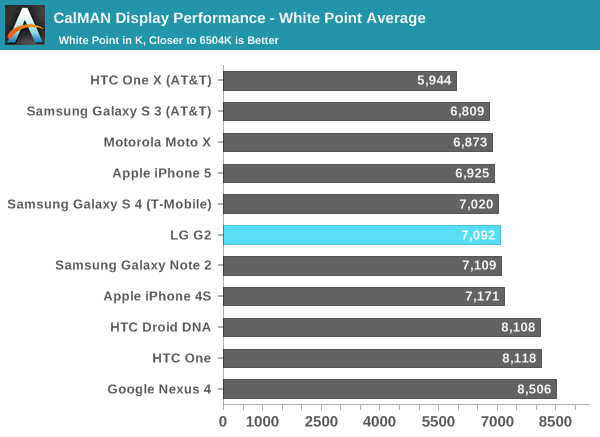
Saturations:
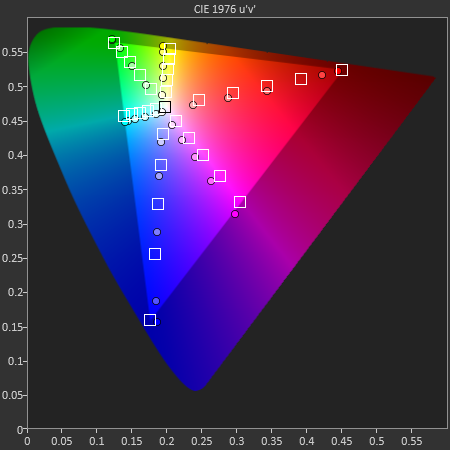

Grayscale Sweep:

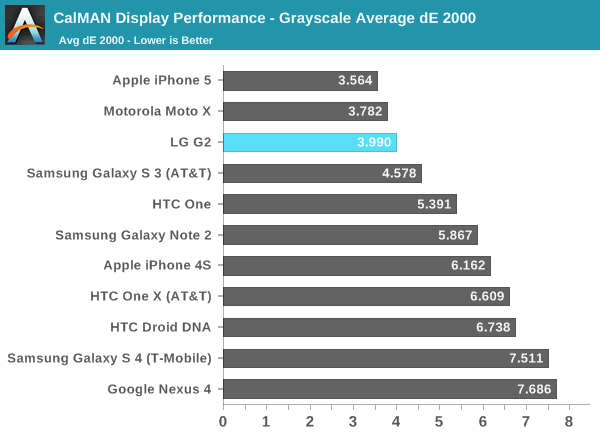
GMB Color Checker:
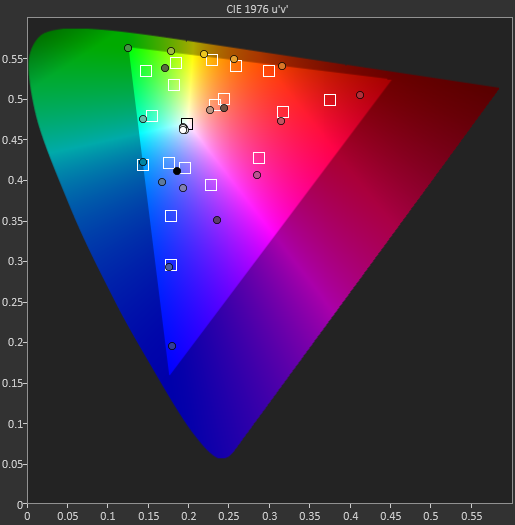
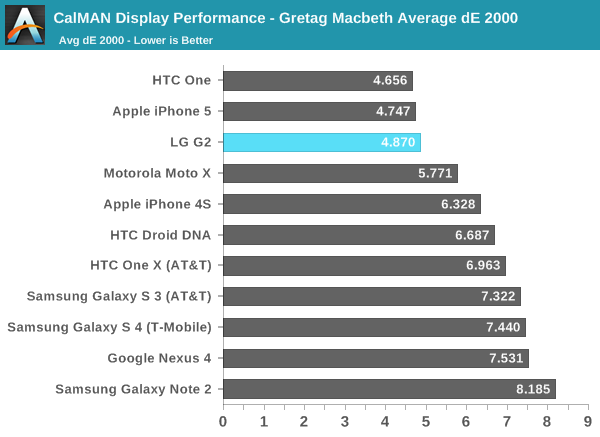
I measured the G2 display and was very impressed with how things turned out. The panel goes nice and bright (around 400 nits) but not quite as high as the 460 from the 720p LG Display panel from the Nexus 4. On the bright side however it comes in close to 6504K in temperature, and has some of the lowest DeltaE 2000 scores we've seen, with the iPhone 5, HTC One, and G2 clustering together in the GMB color checker test and saturations sweep.
















120 Comments
View All Comments
Krysto - Sunday, September 8, 2013 - link
Cortex A9 was great efficiency wise, and better perf/Watt than what Qualcomm had available at the time (S3 Scorpion), but Nvidia still blew it with Tegra 3. So no, that's not the only reason. Nvidia can do certain things like moving to smaller node or keeping the clock speed low of the GPU's, but adding more GPU cores, and so on, to increase efficiency and performance/Watt. But they aren't doing any of that.UpSpin - Sunday, September 8, 2013 - link
You mean they could and should have released more iterations of Tegra 3 and adding more and more GPUs to improve at least the graphics performance than waiting for A15 and Tegra 4.I never designed a SoC myself :-D so I don't know how hard it is but I did lots of PCB which is practically the same except on a much larger scale :-D If you add some parts you have to increase the die size, thus move other parts on the die around, reroute the stuff etc. So it's still a lot of work. The main bottleneck of Tegra 3 is memory bandwidth. So adding more GPU cores without adressing the memory bandwidth would not have made any sense most probably.
They probably expected to ship Tegra 4 SoCs sooner, thus they saw no need in releasing a totally improved Tegra 3 and focused on Tegra 4.
And if you compare Tegra 4 to Tegra 3, then they did exactly what you wanted, moving to a smaller node, increasing the number of GPU cores, moving to A15 while maintaining the power efficient companion core, increasing bandwidth, ...
ESC2000 - Sunday, September 8, 2013 - link
I wonder whether it is more expensive to pay to license ARM's A9, A15, etc (thought they were doing an A12 as well?) or to develop it yourself like Qualcomm does. Obviously QCOM isn't starting from scratch every time, but R&D adds up fast.This isn't a perfect analogy at all but it makes me think of the difference between being a pharmaceutical company that develops your own products and one that makes generic versions of products someone else has already developed once the patent expires. Of course now in the US many companies that technically make their own products from scratch really just take a compound already invented and tweak it a little bit (isolate the one useful isomer, make the chiral version, etc), knowing that it is likely their modified version will be safe and effective just as the existing drug hopefully is. They still get their patent, which they can extend through various manipulations like testing in new populations right before the patent expires, but the R&D costs are much lower. Consumers therefore get many similar versions of drugs that rely on one mechanism of action (see all the SSRIs) and few other choices if that mechanism does not work for them. Not sure how I got off into that but it is something I care about and now maybe some Anandtech readers will know haha.
krumme - Sunday, September 8, 2013 - link
Great story mate :), i like it.balraj - Saturday, September 7, 2013 - link
My first comment on AnandtechThe review was cool...I'm impressed by g2 battery life n camera...
Wish Anandtech can have a UI section
Also can you ppl confirm if lg will support g2 with Atleast 2 yrs of software update
That's gonna be deciding factor in choosing between g2 or nexus 5 for most of us !!!!!!!
Impulses - Saturday, September 7, 2013 - link
Absolutely nobody can guarantee that, even if an LG exec came out and said so there's no guarantee they wouldn't change their mind or a carrier wouldn't delay/block an update... If updates are that important to you, then get a Nexus, end of story.adityasingh - Saturday, September 7, 2013 - link
@Brian could you verify whether the LG G2 uses Snapdragon 800 MSM8974 or MSM8974AB?The "AB" version clocks the CPU at 2.3Ghz, while the standard version tops out at 2.2Ghz.. However you noted in your review that the GPU is clocked at 450Mhz.. If I recall correctly, the "AB" version runs the GPU at 550Mhz.. while the standard is 450Mhz
So in this case the CPU points to one bin.. but the GPU points to another.. Can you please confirm?
Nice "Mini Review" otherwise.. Am looking forward to the full review soon.. Please include the throttling analysis like the one from the MotoX. It would be nice to see how the long the clocks stay at 2.3Ghz :)
Krysto - Sunday, September 8, 2013 - link
He did mention it's the first. no the latter.neoraiden - Saturday, September 7, 2013 - link
Brian could you comment on how the lumia 1020 compares to a cheap ($150-200) camera as I was impressed by the difference in colour for the video comparison even if ois wasn't the best.I currently have a note 2 but the camera quality in low light conditions is just too bad, also the inability to move apps to my memory card has been annoying. I have an upgrade coming up in January I think, but I might try to change phone before. I was wondering whether you could comment on whether the lumia 1020 is worth the jump from android due to picture quality or will an htc one or nexus 5 (if similar to the g2) suffice? I was considering the note 3 as I like everything else but it still doesn't have ois or would the note 3 with a cheap compact be better even given the inconvenience of having to bring a camera?
The main day to day use of my phone is news apps, Internet, email some threaded (which I hear is a problem for windows phone).
abrahavt - Sunday, September 8, 2013 - link
I would wait to see what camera nexus 5 would have. Alternative is to get the Sony QX 100 and you would get great pictures irrespective of the phone